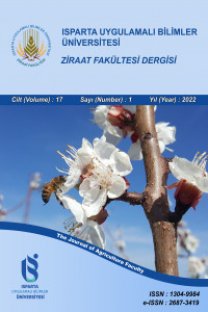Yumurtacı Bıldırcın Kümesinde Derece Gün Yöntemi ile Isıtma ve Soğutma Derece Gün Değerlerinin Belirlenmesi
Bıldırcın, ısıtma ve soğutma, enerji gereksinimi
Determination of the heating and cooling degree day values of laying quail henhouse by the degree day method
Quail heating and cooling, energy requirement, energy analysis,
___
- Alarslan, O.F. and Karadas, F. 1999. The Heat Stress And The Required Measures Should Be Taken in Layer Hens. Information Animal, 1999, 16: 85- 91.
- Atılgan, A., Yücel, A. and Öz, H. 2012. Determination of Heating and Cooling Day Data For Broiler Housing: Isparta case. Journal of Food, Agriculture & Environment, 2012, 10:(3&4 ): 353-356.
- Baêta, F.C. 1998. Acondicionamento Térmico Natural de Galpões Avícolas. Anais do Simpósio Goiano de Avicultura,1998, 9-34.
- Baylan, M., Canogullari, S., Sahinler, S., Uluocak, A.N., and Copur, G. 2009. Effects of Divergent Selection Methods Based on Body Weights of Quail on Improvement of Broiler Quail Parents. Journal of Animal and Veterinary Advances, 2009, 8(5): 962-970.
- Baytorun, A.N., Önder, D., ve Gügercin, Ö. 2016. Seraların Isıtılmasında Kullanılan Fosil ve Jeotermal Enerji Kaynaklarının Karşılaştırılması. Türk Tarım-Gıda Bilim ve Teknoloji Dergisi, 2016, 4 (10): 832-839.
- Büyükalaca, O., Bulut, H. and Yılmaz, T. 2001. Analysis of Variable-Base Heating and Cooling Degree-Days for Turkey. Applied Energy, 2001, 69: 269-283.
- Cahaner, A., and Leenstra, F. 1992. Effects of High Temperature on Growth and Efficiency of Male and Female Broilers From Lines Selected for High Weight Gain, Favorable feed Conversion and High or Low Fat Content. Poultry Science, 1992, 71:1237-1250.
- Daghir, NJ. 1995. Poultry Production in Hot Climates In: Present Status and Future of the poultry Industry in Hot Regions. CAB International, London, pp. 1-12.
- Dombaycı, AÖ. 2009. The Determination of Montly Cooling Degree-Day Numbers for in the Warmest Climate Provinces of Turkey. Mühendislik ve Fen Bilimleri Dergisi, 2009, 27: 208-215.
- dos Santos, TC., Gates, RS., , Tinôco, I. de FF., Zolnier, S., and Baêta, FC., 2017. Behavior of Japanese Quail in Different Air Velocities and Air Temperatures. Pesquisa Agropecuária Brasileira, 2017, 52(5): 344-354.
- El-Tarabany, M.S. 2016. Impact of Temperature-Humidity Index on Egg-Laying Characteristics and Related Stress and Immunity Parameters of Japanese Quails. International Journal of Biometeorology, 2016, 60: 957-964.
- Gölcü, M., Dombaycı, ÖA. ve Abalı, S. 2006. Denizli İçin Optimum Yalıtım Kalınlığının Enerji Tasarrufuna Etkisi ve Sonuçları. Gazi Üniversitesi Mühendislik ve Mimarlık Fakültesi Dergisi, 2006, 21(4): 639-644.
- Haştemoğlu, H.Ş. ve Erkan, İ. 2015. Degree-Day Analysis for Different Locations in Turkey and Effect on Architecture Conceptualism. Journal of Civil Engineering and Architecture, 2015, 9: 1252-1260.
- Henken, A.M., Groote, A.M.J. and Nieuwland, M.G.B. 1982. The effect of environmental temperature on immune response and metabolism of the young chicken. Poultry Science, 1982, 62: 51-58.
- Kocaman, İ., Konukcu, F. ve İstanbulluoğlu, A. 2007. Hayvan Barınaklarında Isı ve Nem Dengesi. KSÜ Fen ve Mühendislik Dergisi, 2007, 10 (1): 134-140.
- Kucuktopcu, E., Cemek, B. and Banda P. 2017. Determination of Poultry House Indoor Heating and Cooling Days Using Degree-Day Method. Agronomy Research, 2017, 15(3): 760-766.
- Mashaly, MM., Hendricks, GL., Kalama, MA., Gehad, AE., Abbas, AO. and Patterson, PH., 2004. Effect of Heat Stress on Production Parameters and İmmune Responses of Commercial Laying Hens. Poultry Science, 2004, 83 (6): 889-94.
- Maton, A., Daelemans, J. and Lambrecht J. 1985. Housing of Animals” Elsevier Science Publishing Company Inc., Newyork.
- Narinç, D. and Aksoy, T. 2012. Effects of Mass Selection Based on Phenotype and Earlyfeed Restriction on the Performance and Carcass Characteristics in Japanese Quails. Kafkas Universitesi Veteriner Fakültesi Dergisi, 2012, 18 (3): 425-430.
- Nazar, F.N. and Marin, RH. 2011. Chronic Stress and Environmental Enrichment as Opposite Factors Affecting the Immune Response in Japanese Quail (Coturnix coturnix japonica). Stress, 2011, 14 (2): 166-73.
- Olgun, M. ve Kodal, S. 1989. Serbest Duraklı Süt Sığırı Ahırlarının Planlanması ve Yapısal Özellikleri, TİGEM Yayın No:10, Ankara.
- Ozbey, O. and Ozcelik, M. 2004. The Effect of High Environmental Temperature on Growth Performance of Japanese Quails with Different Body Weights. International Journal of Poultry Science, 2004, 3 (7): 468-470.
- Özel, M. and Pıhtılı, K. 2008. Determination of Optimum Insulation Thickness by Using Heating and Cooling Degree-Day Values. Mühendislik ve Fen Bilimleri Dergisi, 2008, 26 (3): 191-197.
- Poyraz, O., Inan, M. and Akcan, A. 1991. The Effect of High Environmental Temperature on Layer Hens. I. Some Production Traits. Veterinary Journal of Ankara University, 1991, 38: 24-39.
- Seedorf, J., Hartung, J. and Schröder, M. 1998. A Survey of Ventilation Rates in Livestock Building in Northern Europe. Journal of Agricultural Engineering Research, 1998, 70:39-47.
- Tinôco, IFF. 1995. Estresse calórico e meios naturais de condicionamento.Anais do 1 Simpósio Internacional sobre Ambiência e Instalação na Avicultura Industrial, Campinas, São Paulo. Brasil. Campinas: Facta; 1995. p.99-108.
- Türkoğlu M., Arda M., Yetişir R., Sarıca M. ve Erensayın C. 1997. Tavukçuluk Bilimi. Otak Form Ofset, Samsun.
- Vercese, F., Garcia, E.A., Sartori, J.R., Pontes S.A., Faitarone, ABG., Berto, D.A., Molino, A. and Pelícia, K. 2012. Performance and egg quality of Japanese quails submitted to cyclic heat stress. Rev Bras Ciênc Avícola, 2012, 14:37-41.
- ISSN: 1304-9984
- Yayın Aralığı: Yılda 2 Sayı
- Başlangıç: 2006
- Yayıncı: Isparta Uygulamalı Bilimler Üniversitesi
Handan SARAÇ, Taner DAŞTAN, Hasan DURUKAN, Sevgi DURNA DAŞTAN, Ahmet DEMİRBAŞ, Tolga KARAKÖY
Abdullah ARIN, Hesna Rüveyda AYDIN, Sabri ERBAŞ, Ali COŞKAN
Yarı Kurak Bölgelerde Farklı Arazi Kullanımlarında Toprak Erozyon Duyarlılığının Belirlenmesi
Birinci ve İkinci Ürün Çerezlik Kabağın (Cucurbita Pepo L.) Su Kullanımı ve Veriminin Belirlenmesi
Farklı Sulama Suyu Düzeyi ve Vermikompost Dozlarının Marul Bitkisinin Mikro Element Alımına Etkileri
Hayvancılık İşletmelerinde Endüstriyel Simbiyoz Uygulaması: Bursa Örneği
İlker KILIÇ, Hatice DELİCE, Sinem SOFU, Burak YILDIZ
